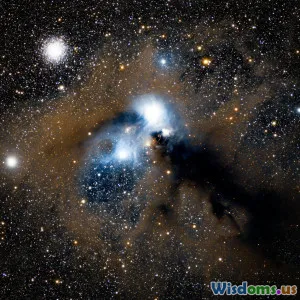
Understanding Black Holes: A Deep Dive
8 min read Explore the mysteries of black holes, their formation, properties, and impact on our understanding of the cosmos. (0 Reviews)
Understanding Black Holes: A Deep Dive
Introduction: Journey into the Darkest Corners of the Universe
Black holes evoke a sense of awe and mystery—massive objects so dense that not even light can escape their grasp. From science fiction tales to groundbreaking astrophysical research, black holes have fascinated humanity for decades. But what exactly are black holes, how do they form, and why do they continue to challenge our understanding of the cosmos? This deep dive will demystify these cosmic enigmas, weaving together the latest scientific insights and real-world examples to illuminate one of space’s most intriguing phenomena.
What Are Black Holes?
A black hole is a region in spacetime exhibiting gravitational acceleration so intense that nothing—no particles or electromagnetic radiation such as light—can escape from it. The boundary beyond which escape becomes impossible is called the event horizon. Once objects pass the event horizon, they are inevitably pulled towards the core or singularity, a point where density becomes infinite and current physics breaks down.
Formation: How Black Holes Come to Be
Most known black holes form from the remnants of massive stars at the end of their evolutionary life cycles. When a star much larger than our Sun exhausts its nuclear fuel, it undergoes a supernova explosion. This cataclysmic blast blows away the star's outer layers, leaving behind a core. If the core is sufficiently massive—typically exceeding about three solar masses—it collapses under its own gravity, forming a black hole.
Beyond stellar black holes, astronomers have discovered supermassive black holes residing at the centers of galaxies. For instance, our own Milky Way hosts Sagittarius A*, a supermassive black hole with about four million times the mass of the Sun. Such giants’ origins remain a subject of ongoing research, with theories proposing growth through accreting mass over billions of years or merging with other black holes.
Types of Black Holes
To understand black holes fully, one must recognize their different categories:
- Stellar Black Holes: These typically contain 5 to several tens of solar masses and form as described above.
- Intermediate Black Holes: These possess hundreds to thousands of solar masses. Though rarer and harder to detect, evidence lies in ultraluminous X-ray sources and specific globular clusters.
- Supermassive Black Holes: Existing at galactic centers with millions to billions of solar masses, supermassives influence galaxy dynamics and star formation.
- Primordial Black Holes: Hypothetical tiny black holes formed shortly after the Big Bang; their existence remains uncertain.
Anatomy of a Black Hole
Event Horizon: The Point of No Return
The event horizon defines the limit where escape velocity equals the speed of light. For a black hole, this radius depends on its mass and is called the Schwarzschild radius. To visualize, a black hole with 10 times the Sun's mass has an event horizon roughly 30 kilometers in diameter — extremely compact compared to its mass.
Singularity: The Heart of Mystery
At the singularity, density and the curvature of spacetime approach infinity. Current fundamental physics, including Einstein’s General Relativity, can’t fully describe conditions at this point. Resolving this requires a theory of quantum gravity, a holy grail in physics.
Accretion Disks and Jets
Black holes often attract surrounding gas and dust forming an accretion disk—a swirling, flattened ring of hot matter spiraling inward. Friction within the disk heats material to extreme temperatures, emitting powerful X-rays detectable by Earth-based instruments. For example, the black hole binary system Cygnus X-1 was the first strong candidate black hole detected via emitted X-rays.
Some black holes, especially supermassives, also launch relativistic jets—narrow beams of particles traveling near light speed. These jets can extend thousands of light-years, impacting galaxy evolution.
Observational Evidence and Recent Discoveries
The direct observation of black holes remained impossible for decades because they emit no light. However, indirect evidence and technological advances have transformed our understanding.
The Event Horizon Telescope and the First Image
In 2019, the Event Horizon Telescope (EHT) collaboration made history by capturing the first-ever image of a black hole’s event horizon, specifically of the supermassive black hole in galaxy M87. This breakthrough offered visual proof supporting Einstein’s predictions and demonstrated humans’ technological reach stretching to the darkest and most remote cosmic realms.
Gravitational Waves and Black Hole Mergers
Another revolutionary leap came with the detection of gravitational waves in 2015 by LIGO (Laser Interferometer Gravitational-Wave Observatory). These ripples in spacetime were generated by the merger of two stellar black holes over a billion light-years away. Since then, dozens of such events have been recorded, providing insights into black hole populations and physics under extreme gravity.
Why Black Holes Matter: The Cosmic and Scientific Significance
Black holes are not mere cosmic oddities. They serve as laboratories to test general relativity and quantum mechanics under extremities unattainable on Earth.
They also influence galaxy formation and evolution. For instance, feedback from supermassive black hole activity regulates star formation rates and disperses gas, shaping galactic architecture.
Furthermore, studying black holes challenges us to develop a unified theory combining gravity with quantum physics, promising revolutions in fundamental science.
Conclusion: Embracing the Cosmic Darkness
Black holes are gateways to understanding the universe’s most profound laws. From their dramatic formation in collapsing stars to the majestic gravitational choreography within galactic hearts, black holes stitch together science’s knowns and unknowns. Advancement in observational astronomy, from X-ray insights to gravitational waves and event horizon images, continues to peel back their veil.
As physicist Stephen Hawking famously said, "Black holes ain't as black as they are painted." They emit mysterious radiation—Hawking radiation—hinting at uncharted physics possibly unlocking new knowledge about the universe's fabric.
By studying black holes, humanity embarks on a grand cosmic quest, transforming these voids of darkness into beacons of enlightenment, inspiring both scientists and dreamers alike.
Rate the Post
User Reviews
Popular Posts




















